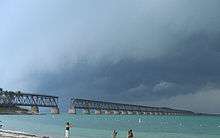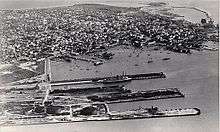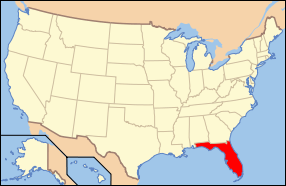Overseas Railroad
|
Overseas Highway and Railway Bridges | |
|
| |
  | |
| Location | Bridges on U.S. 1 between Long and Conch Key, Knight and Little Duck Key, and Bahia Honda and Spanish Key, Florida Keys, Florida |
|---|---|
| Coordinates | 24°42′42″N 81°7′23″W / 24.71167°N 81.12306°WCoordinates: 24°42′42″N 81°7′23″W / 24.71167°N 81.12306°W |
| Area | 30.2 acres (12.2 ha) |
| Built | 1905 |
| Architect | Florida East Coast Railway; Overseas Highway & Toll Bridge Comm. |
| Architectural style | Arch, Girder & Truss Spans |
| NRHP Reference # | 79000684[1] |
| Added to NRHP | August 13, 1979 |
The Overseas Railroad (also known as Florida Overseas Railroad and the Overseas Extension) was an extension of the Florida East Coast Railway to Key West, a city located 128 miles (204.8 km) beyond the end of the Florida peninsula. Work on the line started in 1905[2] and it operated from 1912 to 1935, when part was destroyed by a hurricane.
Henry Flagler and the origin of the Florida East Coast Railway
Henry Flagler (1830–1913) was a principal in Rockefeller, Andrews & Flagler and later a founder of Standard Oil during the Gilded Age in the United States. The wealthy man took interest in Florida while seeking a warmer climate for his ailing first wife in the late 1870s. Returning to Florida in 1881, he became the builder and developer of resort hotels and railroads along the east coast of Florida.
Beginning with St. Augustine, he moved progressively south. Flagler helped develop Ormond Beach, Daytona Beach, Palm Beach, and became known as the Father of Miami, Florida.
Flagler's rail network became known as the Florida East Coast Railway (FEC). By 1904, the FEC had reached Homestead, south of Miami.
Key West Extension: Eighth Wonder of the World
After the United States announced in 1905 the construction of the Panama Canal, Flagler became particularly interested in linking Key West to the mainland. Key West, the United States' closest deep-water port to the Canal, could not only take advantage of Cuban and Latin America trade, but the opening of the Canal would allow significant trade possibilities with the west.
Initially called "Flagler's Folly", the construction of the oversea railroad required many engineering innovations as well as vast amounts of labor and monetary resources. Once the decision was made to move forward with the project, Flagler sent his engineer William J. Krome to survey potential routes for the railroad. The initially favored route extended the railroad from Homestead southwest through the Everglades to Cape Sable, where it would then cross 25 miles of open water to Big Pine Key and then continue to Key West. Though it was quickly determined that it was more feasible to run the railroad south to Key Largo and follow the islands of the Florida Keys. Krome then surveyed routes to Key Largo, including one over Card Point (which would become the first roadway to the Keys) and Jewfish Creek, which was the selected route.[3][4]
At one time during construction, four thousand men were employed. During the seven year construction, three hurricanes—one in 1906, 1909, and 1910—threatened to halt the project. The project cost was more than $50 million.
Despite the hardships, the final link of the Florida East Coast Railway to Trumbo Point in Key West was completed in 1912. In that year, a proud Henry Flagler rode the first train into Key West aboard his private railcar, marking the completion of the railroad's oversea connection to Key West and the linkage by railway of the entire east coast of Florida. It was widely known as the "Eighth Wonder of the World."
Demise
Much of the Overseas Railroad in the Middle Keys was heavily damaged and partially destroyed in the Labor Day Hurricane of 1935, a Category 5 hurricane which is often called "The Storm of the Century". The September 2, 1935, storm killed more than 400 people and devastated Long Key and adjacent areas. The FEC's Long Key Fishing Camp was destroyed, as was an FEC rescue train which, with the exception of steam locomotive 447, was overturned by the storm surge at Islamorada. Over 40 miles of track were washed away by the hurricane, two miles of which ended up washing ashore on the mainland at Cape Sable.[4]
Already bankrupt, the Florida East Coast Railway was financially unable to rebuild the destroyed sections. The roadbed and remaining bridges were sold to the State of Florida, which built the Overseas Highway to Key West, using much of the remaining railway infrastructure. Many of the original bridges were replaced during the 1980s. The Overseas Highway (U.S. 1, which runs from Key West to Fort Kent, Maine) continues to provide a highway link to Key West. Many old concrete bridges of the Overseas Railroad remain in use as fishing piers and pedestrian paths called the Florida Keys Overseas Heritage Trail.[5]
It was added to the National Register of Historic Places in 1979 as Overseas Highway and Railway Bridges.
Gallery
 Florida ECR train in 1912
Florida ECR train in 1912 Florida ECR train in a storm in 1912
Florida ECR train in a storm in 1912.jpg) Florida ECR train in 1928
Florida ECR train in 1928 Henry Flagler's train with his private car "Rambler" returning from Key West, Florida on the Overseas Railroad
Henry Flagler's train with his private car "Rambler" returning from Key West, Florida on the Overseas Railroad Overseas Railroad bridge west of Bahia Honda Key, 2006. The bridge has been severed to allow sailboat traffic
Overseas Railroad bridge west of Bahia Honda Key, 2006. The bridge has been severed to allow sailboat traffic Florida Overseas Railroad map, 1915
Florida Overseas Railroad map, 1915 The FEC yard and station on Trumbo Point in Key West circa 1930.
The FEC yard and station on Trumbo Point in Key West circa 1930.- Arrival of the first train at Key West, January 22, 1912.
References
- ↑ National Park Service (2009-03-13). "National Register Information System". National Register of Historic Places. National Park Service.
- ↑ Born GW (2003)Historic Florida Keys: an illustrated history of Key West & the Keys, HPN Books P47
- ↑ "William Julius Krome". Findagrave.com. Retrieved 16 October 2016.
- 1 2 Hopkins, Alice. "The Development of the Overseas Highway" (PDF). FIU Digital Collections. Florida International University. Retrieved 30 June 2015.
- ↑ "Florida Keys Overseas Heritage Trail". Retrieved 2009-11-27.
Further reading
- Speedway to Sunshine: The Story of the Florida East Coast Railway. Bramson, Seth H. Boston Mills Press, Erin, ONT. 2002
- Standiford, Les (2002). Last train to Paradise. Crown Publishers, New York, NY. ISBN 0-609-60748-0.
- Bethel, Rodman J. Flagler's Folly: The Railroad That Went to Sea and Was Blown Away. 1987. Slumbering Giant Pub Co. ISBN 0961470224; ISBN 978-0961470227
- Heppenheimer, T. A. (2004) "The Railroad That Went to Sea". American Heritage. Winter, 2004. Found at
- Parks, Pat and Corcoran, Tom. The Railroad That Died at Sea: The Florida East Coast's Key West Extension, Revised Edition. 2010. Ketch & Yawl LLC. ISBN 0978894995; ISBN 978-0978894993
External links
- Overseas Railroad at railfan.net
- Florida East Coast Railway Website
- Early Florida East Coast Railway Information
- Flagler Museum - History of the Florida East Coast Railway
- Florida East Coast Railway Society
- Florida Photographic Collection has many photos
- Overseas Railroad at KeysHistory.org
- A Railroad Over the Ocean Surf, by Joe Mitchell Chapple, National Magazine, January 1906
- "History and Background: Construction of the Old Bridge," by Dan Gallagher, Ph.D.
- History of the Key West Extension


